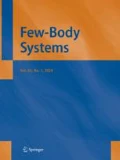Abstract
Here we summarize how the LIT and CC methods can be coupled, in order to allow for ab initio calculations of reactions in medium mass nuclei. Results on 16O are reviewed and preliminary calculations on 40Ca are presented.
Similar content being viewed by others
References
Goldhaber M., Teller EOn nuclear dipole vibrations. Phys. Rev. 74, 1046–1049 (1948)
Steinwedel H., Jensen J.H.DNuclear dipole vibrations. Phys. Rev. 79, 1019–1019 (1950)
Erler, J., Klüpfel, P., Reinhard, P.-GSelf-consistent nuclear mean-field models: example Skyrme-Hartree-Fock. J. Phys. G: Nucl. Part. Phys. 38:033101 and references therein (2011)
Nakatsukasa, TDensity functional approaches to collective phenomena in nuclei: Time-dependent density-functional theory for perturbative and non-perturbative nuclear dynamics. Prog. Theor. Exp. Phys. 01A207 and references therein (2012)
Efros V.D., Leidemann W., Orlandini GResponse functions from integral transforms with a Lorentz kernel. Phys. Lett. B 338, 130–133 (1994)
Efros V.D., Leidemann W., Orlandini G., Barnea NThe Lorentz integral transform (LIT) method and its applications to perturbation-induced reactions. J. Phys. G: Nucl. Part. Phys. 34, R459–R528 (2007)
Kümmel, H., Lührmann, K.H.L., Zabolitzky, J.GMany-fermion theory in e S- (or coupled cluster) form. Phys. Rep. 36, 1–63 (1978)
Bartlett R.J., Musiał MCoupled-cluster theory in quantum chemistry. Rev. Mod. Phys. 79, 291–352 (2007)
Barnea N., Leidemann W., Orlandini GState-dependent effective interaction for the hyperspherical formalism with noncentral forces. Nucl. Phys. A 693, 565–578 (2001)
Efros V.D., Leidemann W., Orlandini GElectromagnetic few-body response functions with the Lorentz integral Transform method. Few-Body Syst. 26, 251–269 (1999)
Andreasi D., Leidemann W., Reiß C., Schwamb MNew inversion methods for the Lorentz Integral Transform. Eur. Phys. J. A 24, 361–372 (2005)
Hagen, G., Papenbrock, T., Dean, D.J., Hjorth-Jensen, MAb initio coupled-cluster approach to nuclear structure with modern nucleon-nucleon interactions. Phys. Rev. C 82, 034330–1–22 (2010)
Entem, D.R., Machleidt, RAccurate charge-dependent nucleon-nucleon potential at fourth order of chiral perturbation theory. Phys. Rev. C 68, 041001–1–5 (2003)
Bacca, S., Barnea, N., Hagen, G., Orlandini, G., Papenbrock, TPhys. Rev, Lett. 111, 122502–1–6 (2013)
Ahrens J. et alTotal nuclear photon absorption cross sections for some light elements. Nucl. Phys. A 251, 479–492 (2003)
Tompkins, J.R., et alMeasurements of the 48Ca(γ, n) reaction. Phys. Rev. C 84, 044331–1–7 (2011)
Author information
Authors and Affiliations
Corresponding author
Additional information
This work was supported by the MIUR grant PRIN-2009TWL3MX, the Natural Sciences and Engineering Research Council, the National Research Council of Canada, the Israel Science Foundation (Grant number 954/09), the US–Israel Binational Science Foundation (Grant No 2012212), the Office of Nuclear Physics, U.S. Department of Energy (Oak Ridge National Laboratory) and DE-SC0008499 (NUCLEI SciDAC collaboration). Computer time was provided by the Innovative and Novel Computational Impact on Theory and Experiment (INCITE) program. This research used resources of the Oak Ridge Leadership Computing Facility located in the Oak Ridge National Laboratory, which is supported by the Office of Science of the Department of Energy under Contract No. DE-AC05-00OR22725, and used computational resources of the National Center for Computational Sciences, the National Institute for Computational Sciences.
Rights and permissions
About this article
Cite this article
Orlandini, G., Bacca, S., Barnea, N. et al. Coupling the Lorentz Integral Transform (LIT) and the Coupled Cluster (CC) Methods: A Way Towards Continuum Spectra of “Not-So-Few-Body” Systems. Few-Body Syst 55, 907–911 (2014). https://doi.org/10.1007/s00601-013-0772-4
Received:
Accepted:
Published:
Issue Date:
DOI: https://doi.org/10.1007/s00601-013-0772-4




